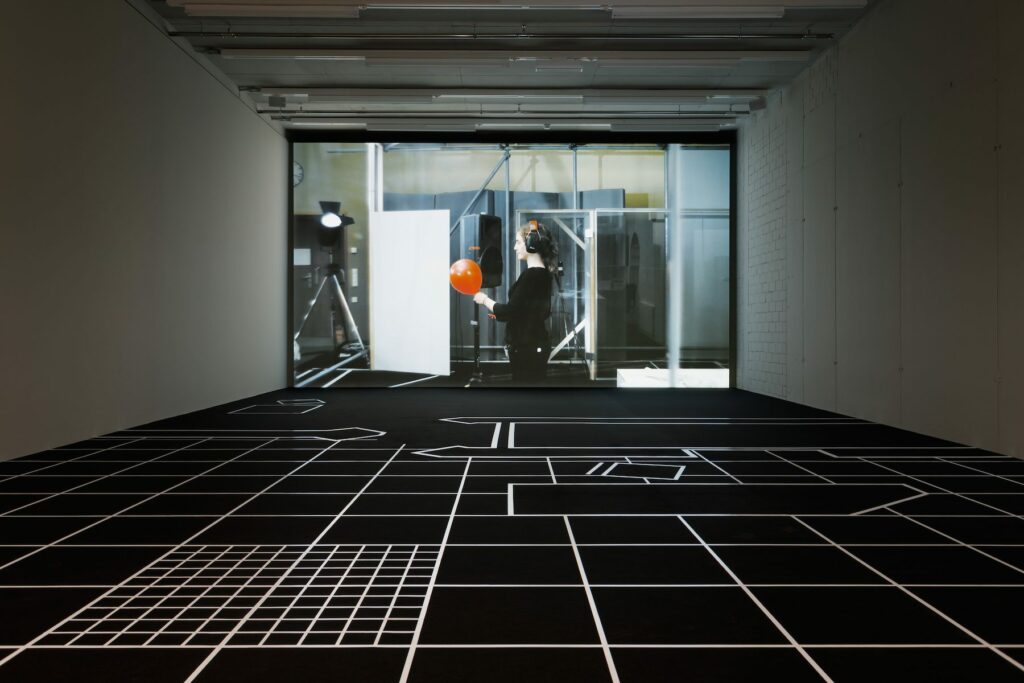Museum MMK Für Moderne Kunst, Frankfurt, Germany
27 Oct 2018 - 21 Jul 2019

Installation view TOWERMMK, Forensic Architecture, 77sqm_9:26min, 2017, © Forensic Architecture, photo: Axel Schneider
Because I live here features 11 artists and artist groups who address themselves to the themes of institutional racism and structural violence in Germany. Their works critically intervene in stereotypical depictions and images that have solidified in clichés.
For the purposes of a film shoot, the staircase of the building in Metzstrasse 11 in Munich becomes a transit space of West Germany in 1975. Inventory (Metzstrasse 11) by Želimir Žilnik portrays the residents – the majority of them so-called guest workers who, one after the other, introduce themselves, say where they come from, when they arrived and a little about their situation in Germany. In-Formation (2005) by Harun Farocki, on the other hand, revolves around the power of representation manifest in statistics about migrants and the stereotypes they create. A wide range of charts and diagrams on migration and immigration from statistical surveys, official publications and textbooks are mounted as a visual vocabulary of our perception. The montage makes the seemingly neutral information of the diagrams appear as one-dimensional clichés that contribute to shaping our perception of reality: a form of visual violence that testifies to both structural and everyday racism. Azin Feizabadi in his film Cryptomnesia (2014), dissolves the images that have congealed in stereotypes by telling the story of migration as the legend of St Reinold, the patron saint of Dortmund. The Frankfurt Sufferhead beer, newly brewed by Emeka Ogboh, links the German reinheitsgebot (purity law) for beer with the existence of Black Germans and, in the language of advertising, reveals the ever-present racism by means of minimal pictorial interventions. Milli’s Awakening (2018) by Natasha A. Kelly shows Black German women’s perspectives on their position in society in eight portraits of cultural professionals who, among other things, take a critical look at the role of art institutions. Erik van Lieshout’s 2006 video of a bicycle trip from Rotterdam to Rostock paints a picture of Germany in shades of resentment, forlornness and social failure. On the way, it becomes ever more evident that the recognition of racism as a fact is not something to be achieved by the aggrieved parties, but has to do with the conception of German identity as such. The video series Normality (1999–2003) by Hito Steyerl documents a number of anti-Semitic and racist-motivated grave desecrations, attacks and acts of violence that, taking place in the background of major national events such as the Expo 2000 and the celebration of the tenth anniversary of German reunification, mirror the continuity of this social reality. Henrike Naumann’s installation, produced especially for this show, draws a connection – both spatially and aesthetically – between the economic violence of the German reunification and the ideological anchor points and formulae of right-wing extremist groups. As far back as 2006, five years before the murders and bomb attacks of the NSU were recognized as right-wing terror, relatives of Halit Yozgat, Enver Şimşek and Mehmet Kubaşık organized the silent protest “Kein 10. Opfer!” (“No 10th Victim!”) to call attention to what the murders had in common. Taking the NSU murders as a point of departure, the portraits by the group spot_the_silence (Rixxa Wendland, Christian Obermüller) show the long history of present-day racism in Germany. Activists and victims of racist violence, for example the pogroms of the 1990s, talk about their experiences and their knowledge, which is systematically ruled out of the discourses conducted within the government authorities and in the media. The perception of this omission led in 2017 to the commission of the group Forensic Architecture. In their work 77sqm_9:26min (2017) they investigate the presence of the former intelligence officer Andreas Temme at the time of Halit Yozgat’s murder. The SPOTS on view in the exhibition were made on the occasion of the 2017 “Unraveling NSU Complex” Tribunal as a series of short film interventions, among them Because I live here (1995/2017), which gave this exhibition its title.
Neither purely artistic nor purely documentary in nature, the works in this exhibition form a category of their own. They examine the structural and institutional racism and violence that represent an attack on our society. In the process, they document, supplement and question the construct of a national homogeneity in which racist violence, in all its forms, is commonplace, and at the same time a phenomenon of which supposedly unaffected persons are often not aware.
With: Harun Farocki, Azin Feizabadi, Forensic Architecture, Natasha A. Kelly, Erik van Lieshout, Henrike Naumann, Emeka Ogboh, spot_the_silence, SPOTS, Hito Steyerl, Želimir Žilnik
.